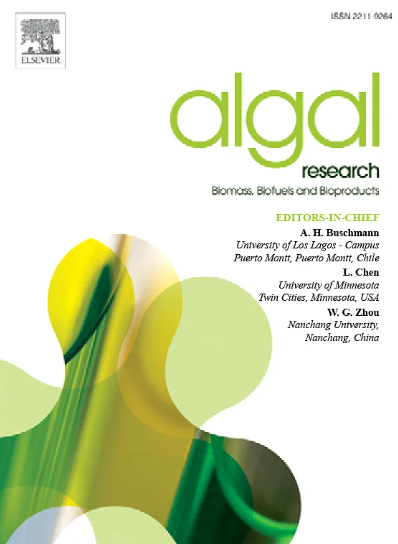杜氏盐藻叶绿体rps2基因的功能研究:增强重组菌对镉的吸附和抗性
IF 4.5
2区 生物学
Q1 BIOTECHNOLOGY & APPLIED MICROBIOLOGY
Algal Research-Biomass Biofuels and Bioproducts
Pub Date : 2025-04-30
DOI:10.1016/j.algal.2025.104075
引用次数: 0
摘要
镉(Cd)是一种有毒的重金属,具有重大的生态和健康风险。Dunaliella salina等海洋微藻对Cd具有良好的吸附和耐受性,是研究Cd毒性和生物修复的重要模型。本研究鉴定了盐藻叶绿体30S核糖体蛋白基因(rps2)是对cd最敏感的基因。在10 μg/L Cd处理下,叶绿体基因组编码的翻译和光合作用相关基因上调,其中rps2持续上调,而在100 μg/L Cd处理下,这些基因下调,其中rps2持续下调。低Cd水平(2.5和25 μg/L)下rps2转录增加,高浓度(250和2500 μg/L)下转录下降,低Cd水平(2.5、25和250 μg/L)下转录水平保持稳定,高浓度(2500 μg/L)下转录水平显著下降。重组菌株表现出更强的Cd耐受性和吸附能力,与对照相比,细胞内Cd水平更高,上清中Cd含量降低。细胞和上清液中均检测到RPS2蛋白。分子量差异(D. salina为63 kDa,重组菌株为99 kDa)表明D. salina存在翻译后裂解。这些发现强调了rps2在Cd生物吸收和耐受中的关键作用,为水生Cd生物修复提供了一条有前景的途径。此外,本研究为进一步探索rps2基因响应重金属胁迫的分子机制提供了理论基础,并揭示了rps2基因潜在的非核糖体功能和核糖体蛋白的翻译后修饰。本文章由计算机程序翻译,如有差异,请以英文原文为准。
Functional insights into the chloroplast rps2 gene from Dunaliella salina: Enhanced cadmium adsorption and resistance in recombinant bacteria
Cadmium (Cd) is a toxic heavy metal that poses significant ecological and health risks. Marine microalgae, such as Dunaliella salina, exhibit remarkable Cd adsorption and tolerance, making them valuable models for studying Cd toxicity and bioremediation. This study identified the chloroplast 30S ribosomal protein gene (rps2) as the most Cd-sensitive gene in D. salina. At 10 μg/L Cd, chloroplast genome-encoded genes related to translation and photosynthesis were upregulated, with rps2 displaying sustained upregulation, whereas at 100 μg/L Cd, these genes were downregulated, with rps2 exhibiting continuous downregulation. rps2 transcription increased at low Cd levels (2.5 and 25 μg/L) but declined at higher concentrations (250 and 2500 μg/L), while protein levels remained stable at low Cd levels (2.5, 25 and 250 μg/L) but dropped significantly at high levels (2500 μg/L). The recombinant strain exhibited enhanced Cd tolerance and adsorption, with higher intracellular Cd levels and reduced Cd in the supernatant compared to controls. The RPS2 protein was detected in both cells and supernatants. Molecular weight discrepancies (63 kDa in D. salina vs. 99 kDa in recombinant strains) suggest post-translational cleavage in D. salina. These findings underscore the critical role of rps2 in Cd biosorption and tolerance, offering a promising approach for aquatic Cd bioremediation. Furthermore, this study provides a theoretical foundation for further exploring of the molecular mechanisms of the rps2 gene in response to heavy metal stress, and highlights potential non-ribosomal functions and post-translational modifications of ribosomal proteins.
求助全文
通过发布文献求助,成功后即可免费获取论文全文。
去求助
来源期刊

Algal Research-Biomass Biofuels and Bioproducts
BIOTECHNOLOGY & APPLIED MICROBIOLOGY-
CiteScore
9.40
自引率
7.80%
发文量
332
期刊介绍:
Algal Research is an international phycology journal covering all areas of emerging technologies in algae biology, biomass production, cultivation, harvesting, extraction, bioproducts, biorefinery, engineering, and econometrics. Algae is defined to include cyanobacteria, microalgae, and protists and symbionts of interest in biotechnology. The journal publishes original research and reviews for the following scope: algal biology, including but not exclusive to: phylogeny, biodiversity, molecular traits, metabolic regulation, and genetic engineering, algal cultivation, e.g. phototrophic systems, heterotrophic systems, and mixotrophic systems, algal harvesting and extraction systems, biotechnology to convert algal biomass and components into biofuels and bioproducts, e.g., nutraceuticals, pharmaceuticals, animal feed, plastics, etc. algal products and their economic assessment
 求助内容:
求助内容: 应助结果提醒方式:
应助结果提醒方式:


